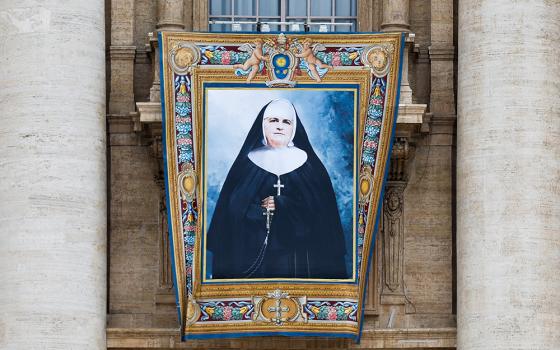I've written a fair bit recently about the expansion of Catholicism in the developing world, especially in Africa, which is creating new centers of pastoral energy and theological insight.
Yet this growth is uneven, and not without its shadows. Aside from Africa, growth has been largely demographic rather than missionary -- driven by increases in the overall population rather than by new conversions. In Latin America, now home to half of the world's Catholic population, Catholicism is actually under siege. Dramatic Protestant gains have come mostly at Catholic expense, creating a historic realignment.
Belgian Passionist Fr. Franz Damen, a veteran staffer for the Bolivian bishops, found that conversions from Catholicism to Protestantism in Latin America during the 20th century actually surpassed the Protestant Reformation in Europe in the 16th century.
Statistics illustrate the point.
Latin American Protestants shot up from 50,000 in 1900 to 64 million in 2000, according to Evangelical scholar William Taylor, with Pentecostal and charismatic churches making up three-quarters of this number. In 1930, Protestants amounted to one percent of the Latin American population; today it's between 12 and 15 percent. A study commissioned in the late 1990s by CELAM, the federation of Latin American Catholic bishops' conferences, found that 8,000 Latin Americans were deserting the Catholic Church for Evangelical Protestantism every day.
Brazil, the largest Catholic country in the world at 149 million, loses half a million Catholics every year. Protestants have grown from nine percent of Brazil's population in 1991 to 15.1 percent (some say as much as 22 percent), while the proportion of Catholics has dropped from 84 percent to 67 percent. In Mexico, 88 percent of a population of 102 million is now Catholic, a decline of 10 percent compared to the mid-20th century.
When the two largest Catholic countries in the world are hemorrhaging, something serious is afoot.
This phenomenon has not escaped the attention of the Vatican. Rarely does a major gathering take place in Rome without discussion of the "sects," the preferred (and slightly pejorative) term for these Protestant bodies. At the Synod of Bishops on the Eucharist in October 2005, Cardinal Claudio Hummes of Sao Paolo, Brazil, bluntly asked, "How long will Latin American be a Catholic continent?"
To discuss these trends, I reached out to Samuel Escobar, one of the world's foremost Evangelical scholars specialized in missionary studies. He grew up as an Evangelical in Arequipa, Peru, and splits time between Eastern Baptist Seminary in Pennsylvania and the Board of International Ministries in Valencia, Spain. His 2002 book, Changing Tides (Orbis), examined the growth of Protestantism in Latin America.
The full text of the interview can be found in the Special Documents section of NCRonline.org: Escobar Interview.
* * *
What explains the growth of Protestantism in Latin America?
One way of explaining it would be the pastoral failure of the Catholic Church, which does not have the resources to educate the people in the faith. Latin American Catholics have a religious sensibility, but are often unattached to the church, and consequently they look for alternatives. The Catholic Church recently carried out a study of more than 1,000 converts, which concluded that if the church had offered deeper Bible study, better worship, and more personal pastoral attention, these people would not have converted. One factor is the shortage of priests. [Note: In 2001, there were 7,176 Catholics for every priest in Latin America, compared to 1,325 Catholics per priest in the United States.]
A deeper reason may be the way Christianity was implanted in Latin America. There was never really a complete missionary effort, the way the missionary orders envisioned it. It was done quickly in order to turn the Indians into subjects of the King, and to collect their tithes.
Some argue that today's conversions to Protestantism are also superficial, and that many will return.
That's a possibility. A recent study in Costa Rica, carried out by a Protestant team, found that eight percent of Costa Ricans who joined a Protestant church eventually left, some to return to Catholicism, while others moved on to something else.
In general, however, most Latin Americans who become evangelicals stay with it, because they find a different approach to understanding the faith and the church. For one thing, evangelical Christianity in Latin America is very much a movement of lay people. There are pastors, many of whom don't have as complete a theological training as Catholic priests, but they rely on their ability to mobilize the people. Protestantism is also home-grown. In Peru, for example, 60 percent of Catholic priests are foreigners -- Spaniards, Americans, Canadians, and so on. The number is just 10 percent in the Protestant churches.
Some charge the United States government and American Protestants have consciously aimed to Latin American Catholicism. What do you think?
That's what we call a conspiracy theory. In fact, those groups that have grown the most dramatically are not related to Protestant bodies in the United States. There are some American denominations that have made considerable missionary efforts, but the bulk of Latin American Protestantism is not an American product. The pastors and leaders are almost entirely native, which disperses the conspiracy theory.
What else explains Protestant expansion?
It's connected with the growth of cities. New arrivals were disoriented, away from their familiar environment, and also from traditional means of social control. Many found a home in the evangelical churches. … The correlation between urbanization and the growth of Protestantism has been clear since the 1950s, and has accelerated in recent years.
These people underwent a conversion experience in which they became masters of their own life. It put an end to an old way of living. Their decision to accept Christ meant a change in patters of behavior which helped people to reorient their lives.
What kind of behavioral changes?
For example, recovering from alcoholism, which is a major problem among the urban poor. Also, becoming better parents, better husbands, and in general developing a stronger sense of personal morality.
Some Catholics say liberation theology "politicized" the church and drove the middle and upper classes into Protestantism.
There may be some truth in that, but it has to be qualified. [In the 1950s], the Catholic Church recognized that it was losing both to Protestantism and to Communism. The working class and the young both seemed more attracted to Marxism than to the church. The bishops asked for help from abroad. In Peru, they went to the United States and asked for missionary priests as a kind of "tithe." The idea was to save people from Communism. Foreign missionaries were sent to work with the poorest of the poor, and they discovered that the problem was not Communism but rather that the church was part of oppressive structures in society. The bishops realigned themselves with the poor. In some forms, this choice became highly politicized, and they forgot about the spiritual dimension -- that is, people need a spiritual experience from the church, not just political guidance. This produced the popular saying that the Catholic Church opted for the poor, and the poor opted for the Pentecostals!
At the same time, however, I'm very conscious that liberation theology responded to a reality in Latin America. We still have the pastoral question of poverty.
It's unfair to blame liberation theology?
Yes. For example, the small Christian communities that were one of the fruits of liberation theology are among the areas in Catholicism in which there has been new life, and a new commitment to the basics of the faith. Civil society in Latin America owes much to these small Christian communities, which have their parallels in Protestantism.
Will the growth in Protestantism continue?
Two things need to be said.
First, there's a new phenomenon, which is the emergence of new charismatic mega-churches, not typical of Protestant churches of the past. They have some similarities with the mega-churches in the United States, though the strongly charismatic element makes them different. They appeal to deep-seated aspects of Catholic culture. They rely on symbols such as blessed water, which classical Protestantism shunned. They also feature a more authoritarian pastoral style and a denial of the priesthood of all believers, which has historically been a key element of Protestant churches.
We might say, therefore, that Protestantism will continue to grow, but what will grow is not classical Protestantism as we have known it.
Second, Protestantism faces a serious pastoral challenge. People are coming to the churches, so the numbers are increasing, but they have very basic pastoral needs. Like in Catholicism, some of these Protestant churches may fail if they don't develop a pastoral strategy that comes out of a reflective theological approach.
The e-mail address for John L. Allen Jr. is jallen@ncronline.org



